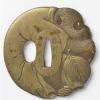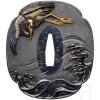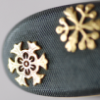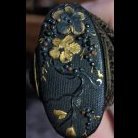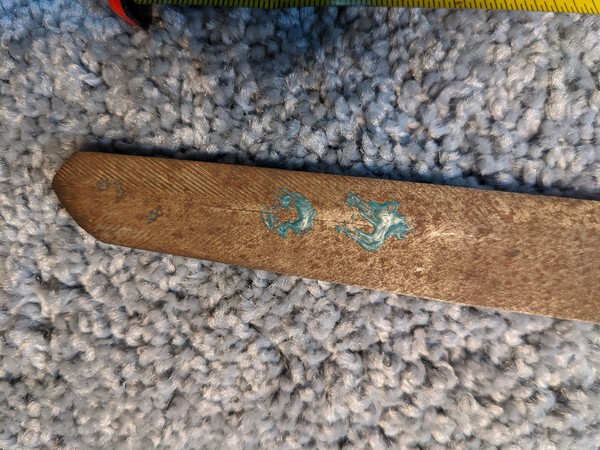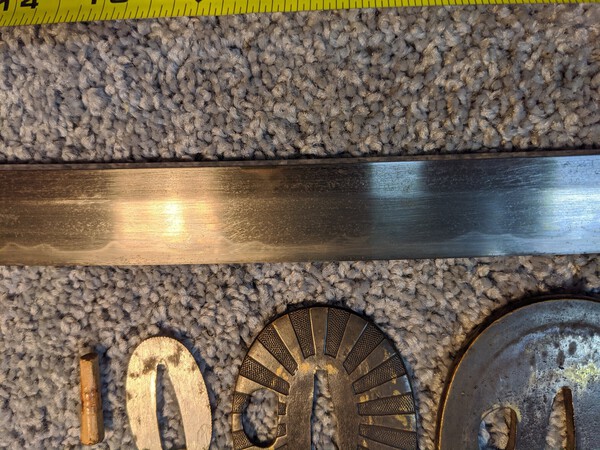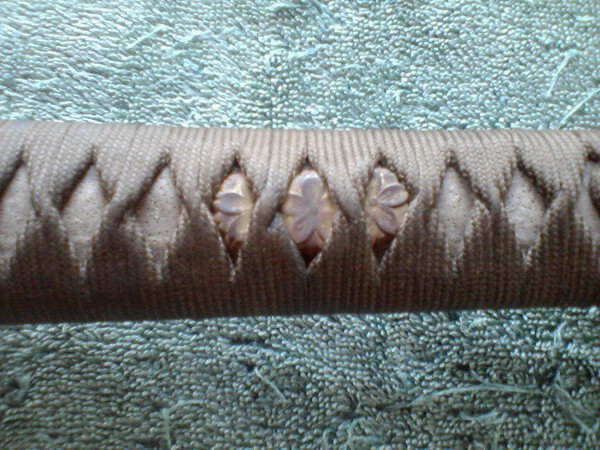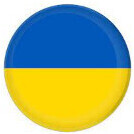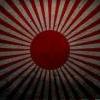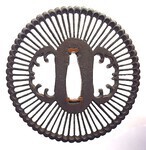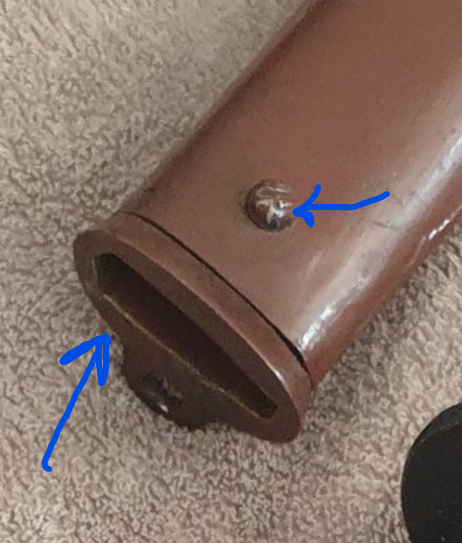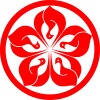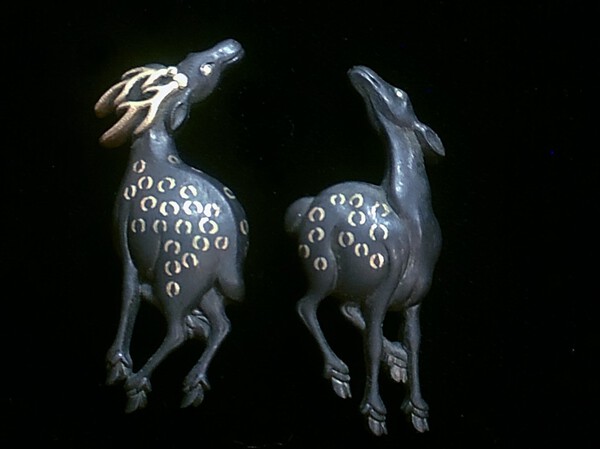Leaderboard
Popular Content
Showing content with the highest reputation on 09/12/2020 in all areas
-
7 points
-
4 points
-
3 points
-
Morita san is the pilar of NMB mei transcription and I have learned so much during these last years. Thank you so much.3 points
-
Seen more than a few black painted tsuba. I just always fig it was field done to make sure sun did not cause a wink and give away position.2 points
-
2 points
-
2 points
-
What I can make out is: “長門国住藤原?太良” Reading of the first two is “Nagato”! Though, “郎“ would make sense, if there wasn’t a third (illegible) kanji....I think?!2 points
-
I'm still so impressed by this iron tsuba, especially those rocks. I've never seen rocks conveyed that way before in a tsuba. Is this Tetsugendo school?2 points
-
名産 Famous (well known) 鐡器 Iron Goods / Iron utensil 謹製 Well-made It's a cast-iron tourist product from Iwate prefecture, I think. There is a consortium of local producers of iron products who produce various goods for tourists: cooking tools, ash trays, wind chimes, teapots, etc. The consortium is called Nambu Tekki (南部鉄器).2 points
-
2 points
-
My guess is that it is supposed to be a pair of buddhist implements: Nyōi and hossu. Nyōi is the Ruyi that is mentioned above (same thing, but Japanese word vs. Chinese word). Hossu is like a brush. They are some of the implements used in Japanese buddhism. Here is another set. The brush on the set in this thread doesn't look very much like a brush, but given the context... I don't know what else it would be. http://www.sword-auction.jp/en/content/af15205-目貫:短冊銘-土屋-menuki-tanzaku-signature-tsuchiya https://en.wikipedia.org/wiki/Hossu2 points
-
Hi Everyone, I've finally gotten around to putting up a thread to show more details on the 4th and final complete blade that my grandpa brought back. Pretty gorgeous looking blade in my opinion, nice hamon, and seems to be in good polish! Lots of little scratches but it's easy to see features through them. I'm curious about the paint on the other side of the nakago from the mei, if anyone could translate those. Take a look and let me know what you think! I believe we had a translation of the mei already: Gotō Hiromasa 後藤廣正 Pics are here: https://imgur.com/a/MxCiizH but i'll put some in this thread so they survive long-term.1 point
-
1 point
-
Well it's getting more interesting. The Same on the tsuka is Same not sandpaper, but very fine scaled rather than the larger nodules normally seen., possibly Dogfish? The Fuchi is ferrous, iron or steel, as are the menuki and the kabutogane, the menuki gilded and the kabutogane plated, possibly with copper. The fuchi heavily corroded but the usual pattern just about visible, the floor-plate pierced for a retaining clip, but not the side, and so never had a clip. This really looks like it is a late war type 98 tsuka. I tried the paint on the tsuba with acetone, it didn't shift at all, so it looks to be wartime paint. I will be leaving it as is for now, and possibly the future.1 point
-
1 point
-
I've spoken to Louis, he is indeed in a far better place now he is out of the nihonto grip and getting stuck into wonderful projects . I think it always stays with you the bug... but better it doesn't control your life as it can for some.1 point
-
Most people I showed it to including everyone on here shouted Gimei. I asked Paul and he eventually (due to time and distance delays agreed with the appraisal) A very noted expert in this field kindly researched this blade for me and told me in a very Japanese way that in its current guise it would be a total waste of money to send it to shinsa with that mei as that smith was noted for never producing swords over 70cm. This sword was at least 85cm. He also stated it would not be worth the cost of polishing in its current state. The mei was wrong. Confirmed by many. The panel was easy to slide out and as I said easy to slide back in. The fold has been cracked to facilitate this. It still matches the two sides perfectly when pushed back in and you can barely notice. So I could send it with the gimei or remove the gimei then get it to shinsa and once I knew more about the sword return the mei back into the panel. History preserved, but me a little more informed on what I have. So really is it worth all this stress over a solution I have found that can be reversed? Also I do not do things lightly or without significant advice as I quite hoped it was shoshin orakaeshi mei. But frankly too many experts say its not. What I asked is will it be acceptable for judgement if they (the shinsa panel) assume that mei lost to history?1 point
-
Remember that all brass was coated with some sort of brown, protective coating from the factory. Polished brass is honest wear or ignorant meddling from people who want shiny. Ultimately though, I'd expect to see more examples of painted tsuba if it was even remotely common. And no, not iron or plain tsuba obviously, I'm talking about decorative patterned tsuba. I guess it's up to you, Dave, whether you clean it off and get it back to spec or leave it as a curiosity and a point of discussion.1 point
-
And this is something gets overlooked sometimes in our "academic"-level discussions. How does it look in hand? From the (poorly lit!!!) picture, it does have that old, worn look. In zooming in, the habaki had been painted and mostly worn off. The seppa look to me to have a brown paint, like to dull the shine that would come from brass fittings.1 point
-
Well, all good points about paint origin. One thing I hope we all can agree on though , the tsuba wasn't painted yesterday, it looks very much like it could have been painted 75 yrs. ago. Too me, it just appears so much like the paint type and wear on my Type 32. This is simply one of those situation which is the fun and yet frustration of the Japanese sword collecting. The inability (sometimes) to be 100% sure... Dave M.1 point
-
Japanese navy often used black paint in addition to bluing to protect metal. This includes type 99 naval special rifles & bayonets.1 point
-
Hi Dave. I'm of the opinion the tsuba is likely later painted. The regulations are pretty clear and I cannot see why an officer would so badly deface their symbol of office. The only plausible theory is to avoid the metal reflecting, but that is so flimsy. The 95 saya were painted black purely as a protective measure I believe, and a crude, rushed one at that. Brass does not need the same protection as steel. Iron tsuba were painted black out of necessity , not trend. As to the never say never, my crude late was sword which was painted all black has a brass tsuba, though it is absolutely spartan without any decoration at all.1 point
-
Absolutely repainted. Where the saya screw has been mangled, there is fresh paint on it.1 point
-
Hi Mark, Someone with better knowledge may chime in and provide better insight, but my understanding is that when there are two Kamon placed together, it could be a commissioned gift to acknowledge or celebrate a marriage - as you say, - or maybe a gift to strengthen an alliance between Daimyo, or I have also heard that Samurai families had a 'main' Mon and a 'secondary' Mon.. So the main or dominant Mon would be displayed more prominently on the Omote and the secondary Mon on the Ura. This rule also applies if it was for a union or marriage.. The stronger family's Mon would be more prevalent or conspicuous on the Omote when worn. You often see this with Menuki.. The Omote will have two Mon on the outside and a single Mon in the centre, and that is reversed on the Ura Menuki.. So making the number of Mons 'equal' but at the same time, not displayed that way.. This can also be done by using Gold and Shakudo when displaying Mon. Gold being more visible. I have read somewhere that the free use of Mons got out of hand (unfortunately) by the end of the Edo Period, so trying to chase genealogy or provenance through the use of Mons can sometimes be a waste of time. Barrie.1 point
-
1 point
-
Please put an option on for 6 month 12 month or 24month. I do not want to do six monthly1 point
-
Dave, I agree with you, that the saya is original (small chip shows bare wood underneath), but the rest is likely post-war. While some Rinji rigs had black-lacquered tsuka, I, personally, have never seen a 98 tsuka or tsuba painted black. The tsuba is correct for a civil blade refitted for the war (hole for retention strap), so the set may have been together in the war. I just can't see it as a wartime job. Having said that, you've probably seen the thread on the multi-colored green painted Type 95 saya. I was convinced it was post-war and stripped it. Shortly afterward, Steve (Shamsy) came up with 2 more! Same paint-scheme! And I had to admit, the paint didn't come off with acetone like post-war paint does. I has to drimmel brush it off. Also, our ongoing discussion of black-painted 95s is leaning toward - not factory original, but a wartime paint by the soldiers. One way to test would be to take a rag and acetone to the backside of one of the seppa or the face of the fuchi, and see if it comes off or if it really resists removal. Wartime paint will not come off without a fight.1 point
-
It can be hard to determine. I had 2 95s that were painted gold & black. When I stripped them, the original paint was underneath the late-war one, but the early one had been totally stripped to the bare metal before repainting. They had even painted the blade! One way to check is to remove the scabbard throat. There is a single screw, visible above, once removed, the throat piece come out. It has a tab that often has the original paint. If it's different, you have proof of re-paint. If the same, then it could be original (or the guy that did the repaint went to that detail on the job).1 point
-
1 point
-
Dear All. Setting problems to one side there are none the less some really nice things being shown. I am particularly drawn to No. 4 from Mauro, that lovely Namban and not a few from Grev's post, not to mention the original selection from Patrice.. If nothing else this is a very pleasant sharing of some treasures. Thank you one and all. All the best.1 point
-
If you search "Island Sword" in the search bar it will bring up a fair bit of information on these.1 point
-
1 point
-
1 point
-
I have not used the GSP for a sword, but have had numerous bad experiences, including excessive unnecessary expense and delay. They once LOST a research microscope, a rather large, heavy, expensive package. Cheers, Michael0 points
-
I have a sword with orakaeshi mei that although preserved by the samurai on shortening is none the less not correct in spite of his belief at the time in the muromachi that it was. The problem is that the smith its claiming to be had a sword length of 70cm approx and rarely exceeded this if ever. It's tachi mei and the mei "panel" is quite easy to remove with only nominal Work and is also easy to replace. If I submit it to shinsa as removed with its little slot empty, will it likely be rejected? Fortunately the panel steel is as corroded as the Nakago so colour wise it's OK. I feel the sword worthy of shinsa and need to know more about it.-1 points






.thumb.jpg.3dee35dfe1a88af94e3515d21fad8b8c.jpg)
